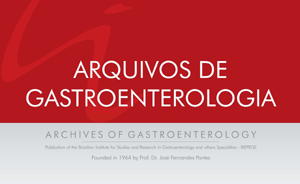RESUMO
CONTEXTO: A desnutrição calórico-proteica é frequente na doença hepática crônica (DHC), no entanto, ferramentas clínicas adequadas para avaliação nutricional destes doentes não estão definidas.
OBJETIVO: Em doentes com DHC, pretendeu-se: 1. Caracterizar a desnutrição calórico-proteica; 2. Comparar diferentes ferramentas clínicas, antropométricas e funcionais de avaliação nutricional; 3. Estudar a associação desnutrição/gravidade da DHC e desnutrição/prognóstico.
MÉTODOS: Estudo observacional e prospetivo. Foram recrutados doentes ambulatórios/hospitalizados de 01-03-2012 a 31-08-2012 e estudados tendo em conta a idade, gênero, etiologia, consumo alcoólico e gravidade da DHC definida pelo score Child-Turcotte-Pugh. A avaliação nutricional incluiu a utilização da avaliação global subjetiva, antropometria nomeadamente índice de massa corporal (IMC), perímetro braquial, circunferência muscular do braço, prega cutânea tricipital e dinamometria. Os doentes foram seguidos durante 2 anos e foi registada a respectiva sobrevida.
RESULTADOS: Foram incluídos 130 doentes com DHC (80 homens) com idade 22-89 anos (média 60 anos). A maioria apresentava cirrose alcoólica (45%). Os doentes hospitalizados apresentaram doença hepática mais severa ( P <0,001) e pior estado nutricional, definido pelo IMC ( P =0,002), perímetro braquial ( P <0,001), circunferência muscular do braço ( P <0,001), prega cutânea tricipital ( P =0,07) e avaliação global subjetiva ( P <0,001). Um terço apresentava força de preensão manual deficiente/baixa. O consumo alcoólico ( P =0,03) e a desnutrição detetada pelo IMC ( P =0,03), perímetro braquial ( P =0,001), prega cutânea tricipital ( P =0,06), circunferência muscular do braço ( P =0,02) e avaliação global subjetiva ( P <0,001) encontraram-se associados à gravidade da DHC. Dos 25 doentes que faleceram durante o seguimento, 17 apresentavam desnutrição severa definida pela prega cutânea tricipital. A desnutrição definida pela prega cutânea tricipital revelou ser um fator preditivo de mortalidade ( P <0,001).
CONCLUSÃO: A desnutrição calórico-proteica é comum na DHC para a qual o álcool desempenha um papel importante. A prega cutânea tricipital é o parâmetro antropométrico mais eficiente e encontra-se associado à mortalidade. A avaliação nutricional deve ser considerada mandatória na abordagem rotineira de doentes com DHC.
DESCRITORES:
Cirrose hepática; complicações; Desnutrição proteico-calórica; Pregas cutâneas; Avaliação nutricional

 Prognóstico e avaliação nutricional de doentes com doença hepática crônica com recurso à antropometria e avaliação global subjetiva
Prognóstico e avaliação nutricional de doentes com doença hepática crônica com recurso à antropometria e avaliação global subjetiva Thumbnail
Thumbnail
 Thumbnail
Thumbnail
 Thumbnail
Thumbnail



